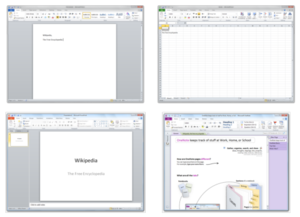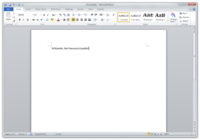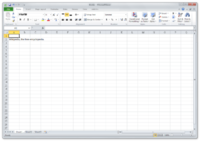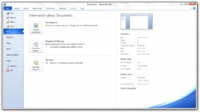- Microsoft Office 2010
-
Microsoft Office 2010 

Microsoft Office 2010 applications shown on Windows 7 (clockwise from top left: Word, Excel, OneNote, PowerPoint; these four programs make up the Home and Student Edition)Developer(s) Microsoft Initial release June 15, 2010[1] Stable release Service Pack 1 (14.0.6023.1000) / June 28, 2011 Operating system Windows 7
Windows Server 2008
Windows Vista with Service Pack 1
Windows Server 2003 R2
Windows XP with Service Pack 3 (32-Bit only)Platform Intel x86 32-bit and 64-bit Available in English, Arabic, Simplified Chinese, Traditional Chinese, Czech, Danish, Dutch, Finnish, French, German, Greek, Hebrew, Hindi, Hungarian, Italian, Japanese, Korean, Lithuanian, Norwegian (Bokmål), Polish, Portuguese (Brazil), Portuguese (Portugal), Romanian, Russian, Slovak, Slovenian, Spanish, Swedish, Thai, Turkish, and Ukrainian.[2] Type Office suite License Proprietary commercial Website microsoft.com/office/2010 Microsoft Office 2010 (also called Office 2010 and Office 14[3]) is a productivity suite for Microsoft Windows,[4] and the successor to Microsoft Office 2007. Office 2010 includes extended file format support,[5] user interface updates,[6] and a changed user experience.[7][8] A 64-bit version of Office 2010[9] is available, although not for Windows XP or Windows Server 2003.[10][11]
On April 15, 2010, Office 2010 was released to manufacturing. The suite became available for retail and online purchase on June 15, 2010.[1][12] Office 2010 is the first version to require product activation for volume license editions.[13]
Office 2010 marks the debut of free online versions of Word, Excel, PowerPoint, and OneNote, which work in the web browsers Internet Explorer, Firefox, Chrome and Safari, but not Opera. Office Starter 2010, a new edition of Office, replaced the low-end home productivity software, Microsoft Works.
Microsoft's update to its mobile productivity suite, Office Mobile 2010, will also be released for Windows Phones running Windows Mobile 6.5 and Windows Phone 7. In Office 2010, every application features the ribbon, including Outlook, OneNote, Publisher, InfoPath, SharePoint Workspace (previously known as Groove), and the new Office Web Apps.
As of July 2011, more than 100 million licenses to Office 2010 have been sold.[14]
Contents
History and development
Development started in 2007 while Microsoft was finishing work on Office 12, released as Microsoft Office 2007. The version number 13 was skipped because of the fear of the number 13.[15] It was previously thought that Office 2010 (then called Office 14) would ship in the first half of 2009.[16]
On January 10, 2009, screenshots of an Office 2010 alpha build were leaked by a tester.
On April 15, 2009, Microsoft confirmed that Office 2010 would be released in the first half of 2010. They announced on May 12, 2009, at a Tech Ed event, a trial version of the 64-bit edition.[17][18] The Technical Preview 1 (Version: 14.0.4006.1010) was leaked on May 15, 2009.[19]
An internal post-beta build was leaked on July 12, 2009. This was newer than the official preview build and included a "Limestone" internal test application.[20] On July 13 Microsoft announced Office 2010 at its Worldwide Partner Conference 2009.
On July 14, 2009, Microsoft started to send out invitations on Microsoft Connect to test an official preview build of Office 2010.[21] On August 30, 2009, the beta build 4417 was leaked on the internet via torrents.[22]
The public beta has been available to subscribers of TechNet, MSDN and Microsoft Connect users as of November 16, 2009.[23] On November 18, 2009, the beta was officially released to the general public at the Microsoft Office Beta website, which was originally launched by Microsoft on November 11, 2009 to provide screenshots of the new office suite.[24] Office 2010 Beta was a free, fully functional version and expired on October 31, 2010.[25]
In an effort to help customers and partners with deployment of Office 2010, Microsoft launched an Office 2010 application compatibility program with tools and guidance available for download.[26] On February 5, 2010, the official release candidate build 4734.1000 was available to Connect and MSDN testers. It was leaked to torrent sites.[27] A few days after, the RTM Escrow build was leaked.
Microsoft announced the RTM on April 15, 2010 and that the final version was to have speech technologies for use with text to speech in Microsoft OneNote, Microsoft PowerPoint, Microsoft Outlook, and Microsoft Word. Office 2010 was to be originally released to business customers on May 12, 2010.[28] Business customers with Software Assurance were able to get it since April 27, 2010 and other Volume Licensing Customers were able to get it since May 1.[29] MSDN and TechNet subscribers have been able to download the RTM version since April 22, 2010. The RTM version number was 14.0.4760.1000.
On June 15, 2010, Office 2010 was released to retail customers.
On November 17, 2010, Microsoft sent out invitations to a select number of testers at the Microsoft Connect portal to test a beta build of Office 2010 Service Pack 1 (SP1).[30] The final version was released to the public on June 28, 2011 with a version number of 14.0.6023.1000.
New features and improvements
Office 2010 is more "role-based" than previous versions.[7] There are features tailored to employees in "roles such as research and development professionals, sales people, and human resources." In its Internet implementation, Office 2010 incorporates features of SharePoint Server and borrows from "Web 2.0" ideas.[31]
Microsoft Office 2010 includes updated support for ISO/IEC 29500:2008, the International Standard version of Office Open XML (OOXML) file format.[5] Office 2010 provides read support for ECMA-376, read/write support for ISO/IEC 29500 Transitional, and read support for ISO/IEC 29500 Strict.[32] In its pre-release (beta) form, however, Office 2010 only supported the Transitional variant, and not the Strict.[33][34] The intent of the ISO/IEC is to allow the removal of the Transitional variant from the ISO/IEC compliant version of the OOXML standard.[34] Microsoft Office 2010 supports OpenDocument Format (ODF) 1.1, which is an OASIS standard.[5]
New features also include a built-in screen capture tool, a background removal tool, a protected document mode, new SmartArt templates and author permissions. The 2007 "Office Button" was replaced with a menu button that leads to a full-window file menu, known as Backstage View, giving easy access to task-centered functions such as printing and sharing. A notable accessibility regression from 2007 is that the menu button scores worse with the Fitts's law accessibility calculation than previous versions. A modified Ribbon interface is present in all Office applications, including Office Outlook, Visio, OneNote, Project, and Publisher. Office applications also have functional jumplists in Windows 7, which would allow easy access to recent items and tasks relevant to the application.[6][35][36] Features of Office 2010 include:
- Ribbon interface and Backstage View across all applications
- Background Removal Tool
- Letter Styling
- The Word 2007 Equation editor is common to all applications, replacing Microsoft Equation Editor 3.0
- New SmartArt templates
- New text and image editing effects
- Screen Capturing and Clipping tools
- Live collaboration functions
- Jumplists in Windows 7
- New animations and transitions in PowerPoint 2010
- View Side by Side/Synchronous Scrolling in Word 2010
A new feature in Microsoft Office 2010 is Outlook Social Connector, which allows users to connect to and receive updates from their social network inside Microsoft Outlook. When users view their emails a name, picture, and title is available for the person they are contacting. Upcoming appointments can also be viewed with this new feature and users can request friends. Outlook Social Connector currently supports Facebook, LinkedIn, MySpace and Windows Live Messenger.[37]
The Volume edition can be activated using a Multiple Activation Key (MAK) which is limited by the number of times a machine can activate when connected to Microsoft's servers,[13] or using a Key Management Server (KMS) which requires activation every 180 days.[13]
Removed features
The following features are removed from Microsoft Office 2010.
- Removed from the entire suite
- Microsoft Office Document Imaging application
- Microsoft Office Document Scanning application
- Office Startup Assistant (Osa.exe)
- Office Diagnostics tool
- Support for MSXML version 5[38]
- Research and Reference pane for Internet Explorer[39]
- Features removed from Microsoft Word
- Smart Tag auto-recognition[40]
- Person Name smart tag
- AutoSummary feature
- Support for Word Add-in Libraries (WLL)[39]
- Features removed from Microsoft Access
- Access Calendar ActiveX control
- Replication Conflict Viewer
- Data access pages[41]
- Features removed from Microsoft Outlook
- ANSI offline Outlook data files (.ost) for Exchange synchronization
- Calendar rebasing tool
- DAV connectivity for HTTP account types
- Exchange 2000 connectivity
- Exchange Message Security feature support
- Postmarks[42]
- Features removed from Microsoft PowerPoint
- Macro recorder
- Save as Web Page feature[43]
- Features removed from Microsoft Publisher
- The ability to create new Web Publications[44]
Editions
Trial Version
The Office 2010 Trial[45] has an option to download the local install, however the default trial installs an App-V image like Office Starter 2010. The Applicatons Virtualization installer will create a Launcher and Office 2010 will run from a virtual drive letter "Q:" rather than installed in "drive:\Program Files\Microsoft Office\Office14". This drive letter is not visible in Windows Explorer. Many programs that rely on Windows apppath variable or program location (like Outlook autodiscover using CNAME record) will fail.
Starter Edition
Office Starter 2010 is an ad-supported product which includes Microsoft Word Starter 2010 and Microsoft Excel Starter 2010. These are reduced-functionality versions for viewing, editing, and creating documents. Office Starter 2010 is only available to original equipment manufacturers (OEM) for preloading on Windows PCs and is intended to replace Microsoft Works. It is only compatible with Windows Vista and Windows 7.[46] The advertisements are displayed in the lower right area of the task pane. It also includes PowerPoint Viewer 2010, to view and print PowerPoint slides and shows. Users who have Office Starter preinstalled are allowed to load it on a USB drive and run it temporarily on any computer to which the USB drive is connected.[47][48] [49]
Office Starter 2010 is available to OEMs for pre-loading on new computers as part of the Office 2010 OEM Pre-installation Kit (OPK). It installs as a virtual application using Microsoft App-V application virtualization technology[50] and can therefore co-exist with full editions of Office. Office Starter 2010 omits several features available only in the full paid version of Microsoft Office. Specifically, it lacks the following features [51][52]:
- Customizable quick access toolbar buttons in both programs
- SmartArt
- Math and equation editing
- Full screen reading view in both programs, custom views in Excel Starter
- Reference features (Citation, Bibliography etc.)
- Tracked changes and comments
- Compare and combining documents
- Document permissions and protection
- Automatic table of contents and table of figures or authorities
- Macros
- Add-ins
- Any additional custom commands not exposed in the ribbon
- Bookmarks
- Cross references
- Footnotes and endnotes
- Captions and index
- Signature line and digital signatures
- AutoText
- Content controls and objects
- Building Blocks Organizer
- Language packs to change the user interface
- Built-in sharing via fax recipient or saving to SharePoint
- PivotTables and PivotCharts in Excel Starter
- Slicers in Excel Starter
- Connections to external data, data validation rules, consolidated data and data tables in Excel Starter
- Error checking, calculation steps and circular references in Excel Starter
- Modifications to column and row headings in Excel Starter
- Ability to toggle row groupings, panes and workbook windows in Excel Starter
Comparison
Table of Editions[53][54][55][56] Suites[57] As an individual product Starter Office Online Home and Student1 Home and Business4 Standard Professional4 Professional Plus Licensing scheme Retail OEM Free Retail Retail Retail2 and Volume Academic[55] and Retail Retail2 and Volume Word Yes Starter edition Basic Yes Yes Yes Yes Yes Excel Yes Starter edition Basic Yes Yes Yes Yes Yes PowerPoint Yes Viewer (Separate) Basic Yes Yes Yes Yes Yes OneNote Yes No Basic Yes Yes Yes Yes Yes Outlook Yes No No No Yes Yes Yes Yes Publisher Yes No No No No Yes Yes Yes Access Yes No No No No No Yes Yes InfoPath No No No No No No No Yes Lync Yes No No No No No No Yes[58][59] SharePoint Workspace No No No No No No No Yes Project Yes No No No No No No No Visio Yes No No No No No No No Office Customization Tool (OCT)3 [60] No No No No No Volume edition only No Volume edition only - Remarks
- 1 Office Home and Student boxed product can be installed on three PCs in the same household and is for non-commercial use.
- 2 Retail version is offered through MSDN or TechNet only.[61]
- 3 Office Customization Tool is used to customize the installation of Office by creating a Windows Installer Patch (.MSP) file and replaces the Custom Installation Wizard and Custom Deployment Wizard included in 2003 and earlier versions of the Office Resource Kit which created a Windows Installer Transform (.MST). Office Customization Tool is only included in Volume License editions.[60]
- 4 Boxed SKUs of Home and Business or Professional editions of the product can be installed on two devices: A primary PC and a portable device such as a laptop.[62]
Office Web Apps
Main article: Office Web AppsMicrosoft now offers a free web-based version of its Office productivity suite, known as Office Web Apps, that started shortly before Office 2010 was released to retail stores.[63] Office Web Apps include online versions of Word, Excel, PowerPoint and OneNote. The web apps allow sharing and collaboration of documents and files and also feature user interfaces similar to their desktop counterparts. Office Web Apps were released to Windows Live Skydrive and SharePoint Workspace on June 2010. You may use the free web-based version of Office to create documents, and can download Office Viewers to view the documents on your system.
Office Mobile 2010
Main article: Microsoft Office MobileThe office suite for Windows Mobile by Microsoft, is updated together with Office 2010. Windows Mobile 6.5 or higher is required to run Microsoft Office Mobile 2010.
Some of the new features included are:[64]- Presentation Companion: The add-on to PowerPoint Mobile allows users to control a presentation through their Windows Phone and display speaker notes.
- Conversation View: Outlook Mobile threads related emails into a group for easier reading and management
- SharePoint Workspace Mobile: The new application allows users to sync documents from SharePoint servers directly to their Windows Phone for offline viewing and editing.
- Support for New Content in Office 2010 such as SmartArt graphics and charts
An upgrade for the existing Windows Mobile 6.5 Phones is provided via Windows Mobile Marketplace, a beta version is already available.
Minimum System Requirements
Suites Processor Memory Hard Disk Space Display Office Home and Student 2010 500 MHz or faster 256 MB RAM; 512 MB recommended 3.0 GB 1024x576 or higher resolution monitor Office Home and Business 2010 500 MHz or faster 256 MB RAM; 512 MB recommended 3.0 GB 1024x576 or higher resolution monitor Office Standard 2010 500 MHz or faster 256 MB RAM; 512 MB recommended 3.0 GB 1024x576 or higher resolution monitor Office Professional 2010 500 MHz or faster 256 MB RAM; 512 MB recommended 3.0 GB 1024x576 or higher resolution monitor Office Professional Plus 2010 500 MHz or faster 256 MB RAM; 512 MB recommended 3.5 GB 1024x768 or higher resolution monitor Office Professional Academic 2010 500 MHz or faster 256 MB RAM; 512 MB recommended 3.0 GB 1024x576 or higher resolution monitor Operating System-Windows XP (must have SP3) (32-bit), Windows 7, Windows Vista with Service Pack (SP) 1, Windows Server 2003 with SP2 and MSXML 6.0 (32-bit Office only), Windows Server 2008, or later 32- or 64-bit OS.
Graphics hardware acceleration requires a DirectX® 9.0c graphics card with 64 MB or more video memory.See also
- Microsoft Office for Mac 2011, the release of Microsoft Office for Mac OS X containing many of Office 2010's new features
- List of office suites
References
- ^ a b "Microsoft Office 2010 Now Available for Consumers Worldwide". http://www.microsoft.com/Presspass/press/2010/jun10/06-152010OfficeLaunchPR.mspx.
- ^ "Language identifiers and OptionState Id values in Office 2010". Microsoft. 2010-05-12. http://technet.microsoft.com/en-us/library/cc179219.aspx. Retrieved 2010-08-16.
- ^ "Office Version Releases And Its Codenaming". http://microsoftoffice2010.us/microsoft-office-versions.
- ^ Bink, Steven (2009-04-10). "Next Office and Exchange named 2010". http://bink.nu/news/next-office-and-exchange-named-2010.aspx. Retrieved 2009-04-10.
- ^ a b c Microsoft Expands List of Formats Supported in Microsoft Office
- ^ a b Microsoft Visio Conference Previews Upcoming New Features for Visio Users
- ^ a b Krill, Paul. "Microsoft eyes 'people-ready' software."InfoWorld, 5 April 2006. Accessed at http://www.infoworld.com/article/06/04/05/77167_HNwittssoftware2006_1.html on February 14, 2007.
- ^ "What is Office Starter 2010? - Starter - Microsoft Office". Officebeta.microsoft.com. accessdate=2010-06-15. http://officebeta.microsoft.com/en-us/msproducts/starter/office-starter-upgrade-to-microsoft-office-2010-FX101792280.aspx.
- ^ Protalinski, Emil (2009-04-14). "Confirmed: Office 2010 comes in 32-bit, 64-bit flavors". http://arstechnica.com/microsoft/news/2009/04/confirmed-office-2010-will-come-in-32-bit-and-64-bit.ars.
- ^ "64-bit editions of Office 2010". Technet.microsoft.com. 2010-05-12. http://technet.microsoft.com/en-us/library/ee681792%28office.14%29.aspx. Retrieved 2010-06-15.
- ^ "Why Office 2010 won't support Windows XP 64-bit". http://arstechnica.com/microsoft/news/2009/12/microsoft-why-office-2010-wont-support-windows-xp-64-bit.ars.
- ^ "Announcement: Office 2010 Available for Consumers Worldwide". http://microsoftoffice2010.us/download-office-2010.
- ^ a b c Plan volume activation of Office 2010
- ^ [1]
- ^ "Office 2010 FAQ". Paul Thurrott. Penton Media, Inc.. May 14, 2009. http://www.winsupersite.com/office/office2010_faq.asp. Retrieved 2009-05-25.
- ^ "Office 14: Think first half of 2009". Mary Jo Foley. CBS Interactive Inc.. February 14, 2007. http://blogs.zdnet.com/microsoft/?p=259. Retrieved 2009-05-25.
- ^ Fried, Ina (May 11, 2009). "Office 2010 preview program coming in July". CNET. http://news.cnet.com/8301-13860_3-10236813-56.html. Retrieved 2010-06-04.
- ^ Protalinski, Emil (April 14, 2009). "Confirmed: Office 2010 will come in 32-bit, 64-bit flavors". Ars Technica. http://arstechnica.com/microsoft/news/2009/04/confirmed-office-2010-will-come-in-32-bit-and-64-bit.ars. Retrieved 2010-06-04.
- ^ Symons, Sam (May 11, 2009). "Sign up for the Office 2010 Technical Preview, due in July". Neowin.net. http://www.neowin.net/news/software/09/05/11/sign-up-for-the-office-2010-technical-preview-due-in-july. Retrieved October 30, 2010.
- ^ "Office 2010 Build 14.0.4302.1000 Leaked". 2009-07-14. http://news.softpedia.com/news/Office-2010-Build-14-0-4302-1000-Leaked-116694.shtml. Retrieved 2009-07-14.
- ^ "Microsoft kicks off Office 2010 Technical Preview". 2009-07-14. http://www.neowin.net/news/main/09/07/14/microsoft-kicks-off-office-2010-technical-preview. Retrieved 2009-07-14.
- ^ "Microsoft Office 2010 Build 4417 Leaks". The Technopath. 2009-08-30. http://thetechnopath.com/microsoft-office-2010-build-4417-beta-1-leaked-screenshots/. Retrieved 2009-08-30.
- ^ [2][dead link]
- ^ McCracken, Harry (November 18, 2009). "Microsoft Opens Up the Office 2010 Beta". Technologizer. http://technologizer.com/2009/11/18/microsoft-opens-up-the-office-2010-beta/. Retrieved October 30, 2010.
- ^ "Office Products - Microsoft Office". Microsoft.com. http://www.microsoft.com/office/2010/en/faqs/default.aspx#16q. Retrieved 2010-06-15.
- ^ "Announcing the Office 2010 Application Compatibility Program - Gray Matter - Site Home - TechNet Blogs". Blogs.technet.com. http://blogs.technet.com/gray_knowlton/archive/2009/10/22/announcing-the-office-2010-application-compatibility-program.aspx. Retrieved 2010-06-15.
- ^ "Office 2010 RC Build 4734.1000 Released - To testers - Softpedia". News.softpedia.com. 2010-02-04. http://news.softpedia.com/news/Office-2010-RC-Build-4734-1000-Released-134098.shtml. Retrieved 2010-06-15.
- ^ "Office 2010 Reaches RTM! - Microsoft Office 2010 Engineering - Site Home - TechNet Blogs". Blogs.technet.com. 2010-04-16. http://blogs.technet.com/office2010/archive/2010/04/15/office-2010-reaches-rtm.aspx. Retrieved 2010-06-15.
- ^ "Office 2010 Clears Last Hurdle to Release - PCWorld Business Center". Pcworld.com. 2010-04-16. http://www.pcworld.com/businesscenter/article/194444/office_2010_clears_last_hurdle_to_release.html?tk=nl_dnx_h_crawl. Retrieved 2010-06-15.
- ^ "Microsoft Office 2010 SP1 beta is out for early testing". thenextweb.com. 2010-11-17. http://thenextweb.com/microsoft/2010/11/17/microsoft-office-2010-sp1-beta-is-out-for-early-testing/. Retrieved 2011-04-09.
- ^ Mary Jo Foley (January 10, 2007). "Microsoft’s Office 2007 team wants in on Web 2.0". All about Microsoft. http://blogs.zdnet.com/microsoft/?p=194. Retrieved 26 September 2010.
- ^ Overview of the XML file formats in Office 2010
- ^ ISO OOXML convener: Microsoft's format "heading for failure"
- ^ a b Microsoft Fails the Standards Test
- ^ Office 2010: New Features
- ^ Microsoft Office Project Conference 2007
- ^ "The power of social networking within Outlook". Microsoft Office Website. Microsoft Corporation. http://office.microsoft.com/en-us/outlook/social-connector-for-microsoft-outlook-HA101794273.aspx. Retrieved 10 October 2010.
- ^ Changes in Office 2010: What's removed
- ^ a b Changes in Word 2010: What's removed
- ^ Smart Tags Overview
- ^ Changes in Access 2010
- ^ Outlook 2010 Changes
- ^ Changes in PowerPoint 2010
- ^ "Changes in Publisher 2010". Technet.microsoft.com. 2010-05-12. http://technet.microsoft.com/en-us/library/ee694636.aspx. Retrieved 2010-06-15.
- ^ http://office.microsoft.com/en-us/try/
- ^ http://pctechwise.com/featured/whats-new-in-microsoft-office-2010
- ^ Foley, Mary Jo (23 November 2009). "Office Starter 2010: The fine print on Microsoft's Works replacement". ZDNet. http://blogs.zdnet.com/microsoft/?p=4643. Retrieved 15 December 2009.
- ^ "New Ways to Try and Buy Microsoft Office 2010". Microsoft Office 2010 Engineering blog. Microsoft Corporation. 7 October 2009. http://blogs.technet.com/office2010/archive/2009/10/07/new-ways-to-try-and-buy-microsoft-office-2010.aspx. Retrieved 15 December 2009.
- ^ "How to Create Portable Office 2010 Starter USB Flash Drive". Blogsdna. 24 November 2009. http://www.blogsdna.com/5795/how-to-create-portable-office-2010-starter-usb-flash-drive.htm. Retrieved 31 March 2011.
- ^ Office 2010 Starter Virtual (Q:) drive may intermittently disappear from My Computer
- ^ Word features that are not fully supported in Word Starter
- ^ Excel features that are not fully supported in Excel Starter
- ^ "Which suite is right for you?". Microsoft Office website. Microsoft Corporation. http://office.microsoft.com/en-us/buy/office-2010-which-suite-is-right-for-you-FX101825640.aspx. Retrieved 5 February 2011.
- ^ "Compare suites available through Volume Licensing". Microsoft Office website. Microsoft Corporation. http://office.microsoft.com/en-us/buy/office-2010-volume-licensing-suites-comparison-FX101825637.aspx. Retrieved 5 February 2011.
- ^ a b "Office Professional Academic". Microsoft Office website. Microsoft Corporation. http://office.microsoft.com/en-us/professional-academic/. Retrieved 5 February 2011.
- ^ "Try & Buy Microsoft Office Online - Packages Overview". Microsoft.com. Microsoft Corporation. http://www7.buyoffice.microsoft.com/usa/default.aspx?cache=1572165943&culture=en-us. Retrieved 13 May 2011.
- ^ "Microsoft Office suites". Microsoft Office website. Microsoft Corporation. http://office.microsoft.com/en-us/suites/. Retrieved 5 February 2011.
- ^ "Microsoft Lync 2010". Microsoft Office website. Microsoft corporation. http://office.microsoft.com/en-us/lync/. Retrieved 5 February 2011.
- ^ "Office Professional Plus 2010". Microsoft Office website. Microsoft corporation. http://office.microsoft.com/en-us/professional-plus/. Retrieved 5 February 2011.
- ^ a b "Office Customization Tool in Office 2010: Office 2010 Technical Reference". Microsoft TechNet. Microsoft Corporation. 16 December 2010. http://technet.microsoft.com/en-us/library/cc179097(office.14).aspx. Retrieved 5 February 2011. "The OCT is available only with volume licensed versions of Office 2010 and the 2007 Office system. To determine whether an Office 2010 installation is a volume licensed version, check the Office 2010 installation disk to see whether it contains a folder named Admin. If the Admin folder exists, the disk is a volume license edition."
- ^ "Microsoft releases Office 2010, SharePoint 2010 to TechNet, MSDN". ZDNet. CBS Interactive. 22 April 2010. http://blogs.zdnet.com/Bott/?p=2025. Retrieved 5 February 2011. "Currently, two downloads are available at each site: 32-bit (x86) and 64-bit (x64) versions of the Professional Plus Retail e(.MSP) file and replaces the Custom Installation Wizard and Custom Deployment Wizard included in 2003 and earlier versions of the Office Resource Kit which created a Windows Installer Transform (.MST)."
- ^ "Office 2010 Frequently Asked Questions". Microsoft Office website. Microsoft Corporation. http://office.microsoft.com/en-us/products/office-2010-frequently-asked-questions-HA101674631.aspx. Retrieved 20 September 2011. "If you purchase a Traditional Disc retail license of Office Home and Business 2010 or Office Professional 2010, the retail license terms allow you to install, activate, and use Office Home and Business 2010 or Office Professional 2010 on your primary PC and your portable device such as your laptop. This license is for your use exclusively."
- ^ Microsoft Office 14 To Include Web Apps
- ^ "Top 10 benefits of Office Mobile 2010". Microsoft.com. http://www.microsoft.com/office/2010/en/mobile/default.aspx.
External links
Microsoft Office Office suites Windows Mac OS Applications Desktop Access · Excel (Viewer) · InfoPath · Lync · OneNote · Outlook (Outlook Connector · Add-ins) · PowerPoint (Viewer) · Project · Publisher · SharePoint Designer · SharePoint Workspace · Visio · Word (Viewer)Server Forms Server · Groove Server · Lync Server · PerformancePoint Server · Project Server (Project Portfolio Server) · SharePoint Server (Excel Services · InfoPath Forms Services)Mobile Online Office tools Microsoft Office shared tools · Ribbon Hero 2Discontinued Related Technologies Categories:- Microsoft Office
- Windows software
Wikimedia Foundation. 2010.





